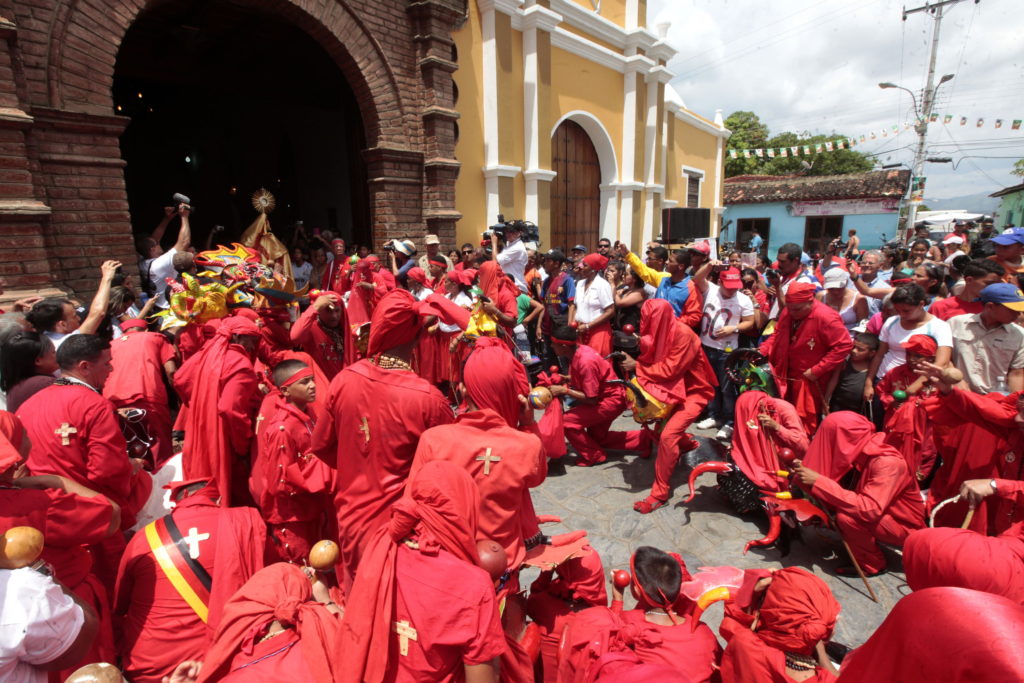Language, tradition, dance, ritual, religion
Today The Devil Dancers festivity is celebrated in some of the coastal towns in Venezuela, as grounds of Corpus Christi Catholic festivity. This is one of the Venezuelan oldest, religious, cultural and artistic manifestations. They were recognized by UNESCO as Intangible Cultural Heritage in 2012. Nowadays there are 11 official brotherhoods recognised internationally. They belong to the towns of San Francisco de Yare, Cata, de Patanemo, San Millán, Ocumare, Naiguatá, among others.
The Venezuelan writer Juan Liscano (1915-2001) was the one who best to describe this festivity, known as “Diablada”.
‘San Francisco de Yare was part of a country that was not transformed by the oil industry… The modesty of their celebration reflected the modesty of their customs; they were used to live in shortage.
One Thursday in June 1947…a group of people from the National Folk Searching Service travelled to this town close to Caracas…San Francisco de Yare… where they celebrate Corpus Christi Day with a devil dancing festivity… Their peaceful faces, measured gestures and organised actions became turbulent by a strong a temporal wind… They were covered in fascinating devil masks, dressing all in red, who were dancing to the rhythm of one drum in front of the gate of the church, as if they were possessed.
For the third time, the bells rang to call the people of the town to attend the solemn mass; the devils were barging at one of the corners of the main square, following the rhythm of the drum and getting closer to the church. They were around 80 participants, dressed in red and on their shoulders they were wearing a palm cross. Their masks had horns. On their waist a rosary hangs as a belt…They had a maraca on their right hand and they were waving it.
The astonish courtship went to the gate of the church and stopped there dancing until the mass started. Then, they devil dancers vanished on the floor and they contracted themselves as if they were in pain. They tried to get up to start dancing again, but vanished once again. They try to get closer, but could not reach the altar. After a while they formed 2 rows and kneeled. Then two tall devils wearing bigger masks with 3 horns moved forward they were the Boss of the’ Diablada’ and his helper. All the symbolism of the dancing was based on the cross…. And in their symbolic representation of the duality in between the good and evil fight…the dancing became desperate and faster. Dancers were exaggerating and intensifying their movements. Meanwhile, the priest reached the altar and raised the Corpus Chirsti figure. The devil dancers were surrounded and started doing their final journey.
When the mass was finished, the Boss and the entire devil dancers started walking and dancing through the town”
El lenguaje de los Diablos. Banesco contigo Publisher. Pgs. 115 to 125.
Author: Carla Soto
Images:
- http://losdiablosdeyare.blogspot.ca/
- http://albaciudad.org/2015/06/en-fotos-las-mascaras-de-tradicion-acompanan-a-los-diablos-danzantes-de-yare-en-su-danzar/
![DSC_7323aa [1600x1200]](https://www.sentirvenezuela.ca/wp-content/uploads/2016/05/DSC_7323aa-1600x1200-1024x680.jpg)
